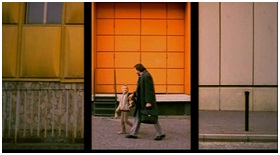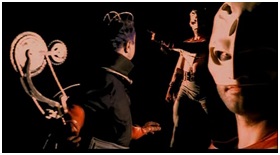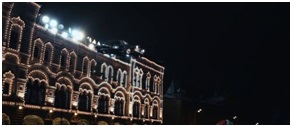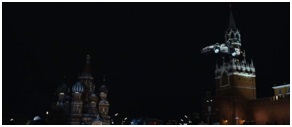Bence Kránicz
kranicz.bence@gmail.com
False Gods. Superhero Myths and Graphic Storytelling in Contemporary Eastern European Cinema[1] (download pdf)
Abstract. The paper examines how certain contemporary Eastern European genre films use superhero myths rooted in American comic books, and apply specific techniques and methods of graphic storytelling.
Besides the visual connections between the two media, film and comics, the paper also addresses the subject of intermediality and adaptation through the representation of the protagonist, and deals with questions concerning postcolonial and postsocialist interpretations of superhero adaptations outside of the United States. It focuses on the connections and continuity between national mass culture, folklore and contemporary national genre films, and briefly examines other ways of intermediality in national genre movies (film and literature, film and video games), dealing with film in an artistic oeuvre or the larger context of big-budget national genre movies produced for both local and international markets.
The interpretations focus primarily on Shaman Vs. Ikarus (György Pálfi, Hungary, 2002) and Black Lightning (Dmitry Kiselev – Aleksandr Voitinsky, Russia, 2009), but also hint at other non-American superhero movies (e.g. Gagamboy, Krrish), Russian genre films (Night Watch, Hardcore Henry) and Hungarian art films (Taxidermia), as well as the possibility of reading certain Eastern European fantasy films as tales of national superheroes.
Keywords: superheroes, popular myths, visual narrative, comic books, masculinity, postsocialism
We live in the age of superheroes. No complicated explanations are necessary to see that films involving superheroes – mainly adaptations of stories from another medium, such as comic books – are highly successful on the global market, and should be considered an important trend of contemporary mainstream cinema. This is what the success of Hollywood consists in, a success mainly of a financial nature. Before the 2000s only one comic book adaptation finished as the top-grossing film of the year on the American domestic market. After 2000 the same happened four times, and all four of those films were superhero movies.[2] The tendency is also visible on the international market: since 2000 two comic book adaptations (both of them superhero movies) have gained the position of the highest-grossing film of a given year.[3]
Without exception, these films are megapics produced by major Hollywood studios on a high budget, which means they are distributed globally on as many markets as possible. This also means that they influence popular cinema outside of the United States as well. My paper focuses on this subject: not the American superhero movies, but the ones produced outside of the US, by smaller national film industries which can be considered peripheral from the point of view of the American audiences and distribution. The term “peripheral” needs to be explained and clarified instantly, since by adapting American superhero stories the national film industries in case open a “third space” through hybridity, mixing elements of both cultures, thus attempting to destroy the oppositions between “centre” and “periphery” (Wang and Yueh-yu Yeh 2005).
In this paper I aim to examine how the superhero genre and characters are interpreted, adapted and changed in the context of two Eastern European film industries. How do the writers and directors create an American-type superhero in their own national environment and local culture? How do they aim to reposition their own national film industry on the global market through these characters and films? Are there any stylistic elements kept in the respective films from comic books, the original medium of the most famous superheroes? Do the resulting films function as superhero parodies or “serious” superhero movies (meaning superhero stories played for a dramatic effect instead of comedy)? And last but not least: do these national superheroes function as tools of criticising and opposing the West?
Who Are the Superheroes and What Do They Do in Eastern Europe?
Superheroes are globally present and open to interpretation. All nations, ethnicities and cultures create their own superheroes – in fact, certain mythic figures and characters of national folklore can be considered superheroes in the first place. This is true in spite of the fact that most English-language theoretical works on the subject mainly consider comic book characters created from the 1930s onwards when defining superheroes. The bulk of these works define superheroes as fictional characters with extraordinary physical and/or mental abilities, who use their skills protecting not just their loved ones, but large groups (even societies) of average people. As Fingeroth argues, among the defining characteristics of superheroes “the most obvious things are: some sort of strength of character (though it may be buried), some system of (generally-thought-to-be) positive values, and a determination to, no matter what, protect those values” (Fingeroth 2004, 17). Another definition states that “the main theme that can be applied to superhero narratives is the cult of the individual; that is the focus on a single person with a great kind of power, usually a combination of mental and physical strength, who succeeds against all odds” (Gray II and Kaklamanidou 2011, 4).
It is safe to say though that there is a certain theoretical gap or ambiguity present here: if we consider Batman a superhero, a man with above-average physical skills, a detective’s mind and of considerable wealth, who vows to protect his fellow men after his personal loss, why don’t we consider Zorro a superhero as well? After all, he can be described with exactly the same words. This conflict between different definitions remains unresolved. One can only assume that American scholars tend to forget about the fact that the concept of the American-type superheroes can be connected to other nations’ folklore, fables and popular culture. This makes it easier to adapt these characters to local contexts, while the adaptation itself inherently calls for the use of postcolonial theoretical concepts and methods, both because of the nexus between the peripheral and the globally present Hollywood film industries, and the symbolic role of the superheroes as popcultural agents of American military, cultural and ideological dominance over the rest of the world.
Adapted, “nationalized” superheroes can serve multiple purposes. Evidently, their creators are tempted by the promise of financial success: since superhero movies form a globally popular group of films, it’s only natural that film industries outside of Hollywood also try to create their own superheroes. Ideally, the new characters will interest local audiences (because they operate in local spaces and contexts), and will be marketable on the global market (because the superhero genre is popular almost everywhere).
The promise of success on both the local and international markets clearly led the distribution plan of a number of recent non-American superhero films. The big-budget Bollywood production of Krrish (Rakesh Roshan, 2006) and its sequel, Krrish 3 (Rakesh Roshan, 2013) were distributed on many foreign markets, in 8 and 13 countries, respectively.[4] Krrish grossed 1,4m USD in India, and another 16m worldwide, which shows the film’s worldwide appeal.[5] The Russian superhero movie Black Lightning (Chernaya molniya, Dmitriy Kiselev, Aleksandr Voytinskiy, 2009), which I will be examining in fuller detail later on, was distributed in 30 countries either in cinemas, on DVD or on television.[6]
However, these iconic characters of Western, particularly American popular culture have a different significance in national-peripheral cultures: they can be interpreted as symbols of Western cultural dominance. As the author of a paper on a recent Mexican superhero comic book puts it: “[…] the modern moral code inherent in the superhero profile was not built originally on philosophical universals, but on a national ethos. Thus, a close relationship can be discerned between a national, status quo vision of modernity and the emergent twentieth century cultural figure of the superhero: ʻthe American Way’ of individualism and capitalist democracy in superhuman form, dressed up in tights for good measure” (Campbell 2009, 29). An “ethnicized” superhero (of American origin, but operating in local spaces and contexts) means something different in countries with historical pasts as colonies, or historical and ideological opposition to the West. In the cases of Indian, Russian or Japanese superheroes, the symbolic-ideological position of the protagonist becomes essential, and can be analysed using methods of postcolonial or postsocialist theories. In fact, simply the adaptation of the superhero can be seen as a gesture of mimicking, which contributes to the deconstruction of Western cultural hegemony (Dudrah 2006).
A mixture of concepts from these theoretical frameworks ought to be applied when dealing with Eastern European superheroes, because both the Hungarian short film Sha-Man Vs. Ikarus (Táltosember Vs. Ikarus, György Pálfi, 2002) and the Russian feature film Black Lightning follow the same narrative method: they use the archetypical character and storyline of the American superhero to define their relation to the Soviet past.
Shadows of Our Life in the Eastern Bloc
Sha-Man Vs. Ikarus[7] is an 18-minute Hungarian short film directed by György Pálfi. It was screened as part of the omnibus project A Bus Came… (Jött egy busz, 2003), which consisted of five short films directed by five then-upcoming Hungarian directors. In a sense A Bus Came… was a showcase of Hungarian talent in film and new directions of Hungarian cinema, which highlights the importance of the fact that Pálfi used the superhero genre, then unknown in Hungarian cinema, for his approach.
His film is inspired by the ancient Greek myth of Ikarus and his father, Daedalus. In Pálfi’s version Daedalus, here called Daeda and presented as a comic-book supervillain, tries to resurrect his son, Ikarus, and presumably gain control over the world. His son, though, is not a person but the collective entity of the bus vehicles used for public transport in present-day Budapest – a special brand of Socialist-era buses still in use, called Ikarus. The only one who can stop Daeda is Sha-Man, the superhero of Budapest, a middle-aged, caring father in his daily life, and a fearless superhero at night. Sha-Man’s name comes from the word “sámán” – shamans were medieval priests of Hungarian tribes before the country adopted Christianity, and are part of Hungarian national folklore. Thus the film connects local and “international” myths, tales of old times and the 20th century.
Even the narrative summary of Pálfi’s film reveals that Sha-Man Vs. Ikarus is indeed a superhero parody, which partly explains why Pálfi was so keen on using self-reflexive, comicbook-inspired stylistic elements throughout the film. According to the director’s approach, superheroes are evidently parodistic characters in the Eastern European context, both because of the different cultural background, the lack of present-day mythic tales in a country which endured so much suffering during the 20th century, and the insufficient financial and technical background to present on-screen superheroes, using up-to-date special effects. Thus parody is the proper genre for a Hungarian superhero tale, and because parodies are often considered inherently self-reflexive films (mixing different genres, playing with narrative tools and visual elements), Pálfi is not afraid to apply a self-conscious, often alienating visual inventory. As Gehring argues, “self-consciousness represents the ultimate parody prick, since nothing affectionately deflates a celebrated genre or auteur faster than a comic reminder that this is, indeed, only a movie” (Gehring 1999, 16).
The self-reflexive style in question comes directly from the visual inventory of comics, which is a postmodernist trick in itself, since Sha-Man Vs. Ikarus is not an adaptation of a single comic book. Mainstream comic book adaptations usually tend to leave behind all stylistic elements of the original medium, because visual tools, which are perfectly normal and mainstream in comics, become transgressive and alienating on screen. Comic book films which use some of these techniques are typically parodies, e. g. the American Scott Pilgrim vs. the World (Edgar Wright, 2010), with its split-screens and visible sound effects, or Gagamboy (Erik Matti, 2004), produced in the Philippines, using frequent axial jumps.[8]
The dominating visual tools of Sha-Man Vs. Ikarus are diegetic frames and the split-screen effect. Pálfi and his DoP, Gergely Pohárnok constantly play with split screens of different shapes and numbers, resembling comic book panels, guiding the audience through an intimate dinner scene in an apartment using at least three split screens with moving cameras and characters, who are drifting from one screen to another from unexpected directions, confusing the audience in their spatial orientation. In other scenes, the director creates diegetic frames: the space inside of a bus, divided into different sections by the stanchions, or the long-shot of a bus garage, where the separate garage doors form separate on-screen frames [Figs.1–4]. These visual tools and some computer-generated images form the visual excess of Sha-Man Vs. Ikarus, and move the film closer to the self-reflexive approach of the superhero genre.




Beside this unique form of “graphic storytelling,”[9] Sha-Man Vs. Ikarus is notable because of its place in Pálfi’s auteuristic oeuvre, the way it introduces superheroes into contemporary Eastern European cinema: as agents of the auteurs’ art cinema. The director sets up a mythical war in our everyday world, and uses precisely the dull objects of this world (buses, especially) as symbols of this battle of ancient origins. The name Ikarus connects and mixes two different pasts: the mythic past of Hellenic gods and the real past of Soviet oppression.[10] The parodistic effect partly comes from the fact that the banal, everyday situations of present-day Hungary are stylised into the setting of a supernatural battle – and also from Pálfi’s joke about building the myth of the socialist decades of Hungary. Thus Sha-Man Vs. Ikarus puts a postmodern twist on two separate “heroic ages.”
Stylising real past and real present into mythical, folkloristic time and space is a method Pálfi follows frequently in his films. Without analysing further his oeuvre, I would only like to hint at the timeless, or rather out-of-time Hungarian village of his debut feature film Hukkle (2002); the transformation of landmark historical moments of the 20th century into a symbolic family tale of generations in Taxidermia (2006); the magical-realist events in present-day Budapest in Free Fall (Szabadesés, 2014); and his unfinished project based on Toldi, a famous Hungarian heroic saga from the 19th century, envisioned as a “medieval action film.” The adaptation of the superhero character fits perfectly into this group of films, which build bridges between realistic and mythic worlds and tropes.
Putin’s Own Superhero
When analysing the Russian superhero movie, a question arises: can postcolonial theories be applied to the cases of postsocialist countries, especially Russia? The problem is contradictory. On the one hand, the Soviet Union acted as a colonising power in the Eastern Bloc after World War II, while simultaneously the Soviet state oppressed and deformed the Russian culture.[11] After the fall of the Soviet Union, Western cultural influence left its mark on the Russian film industry and the films’ attendance, just like in every other country in Eastern Europe: in 1985, 40 Soviet films were attended by more than 5 million people, while in 1994 not a single Russian film was seen by more than 500.000 people (Larsen 1999, 193).
Angles of postcolonial interpretations seem to be relevant in the case of Black Lightning for two reasons. Russian stereotypes about the peoples of the ex-Soviet countries are still lingering in the film, echoing the colonising attitude of the Soviet Union. On the other hand, contemporary Russia is similar to other ex-colonies in the sense that Eastern Europe is often considered a homogeneous geopolitical unit and the Other of Western Europe (Mazierska et al. 2013, 22).
The cultural dominance of the United States, mirrored by the number of attendance of films screened in Russia, focused attention on the significance of producing genre films. In the 1990s many Russian film critics and other members of the film industry shared the opinion that it was essential to produce genre films to attract audiences, if they aimed to revitalise the Russian film industry (Seckler 2009). Like other national film industries in Europe, Russian filmmakers realised they had to learn the rules of professional genre filmmaking if they wanted to compete with American genre films. This task was not easy at all – as the author of a paper on contemporary Russian genre film emphasises, “not a single Russian film was able to reach high professional standards” (Komm 2002).
Among others, Dmitriy Komm wrote about the demand for a new cinematic national myth, which could serve as the foundation of the local genre film production. To follow his train of thought: the superhero genre is perfectly suitable for creating modern national myths, as seen by the present-day popularity of superhero characters created in America in the 1930s. Black Lightning, the superhero saving Russia, emphasises the moral superiority of the “Russian Way,” the refusal of the Western capitalist logic, also functioning as an answer for American genre films. Dmitriy Kiselev and Aleksandr Voytinskiy’s Black Lightning uses motifs from several contemporary American blockbusters, such as the Transformers films, but first and foremost, Spider-Man: the protagonist’s trauma and motivations, the sense of responsibility fuelled by guilt are elements directly lifted from Spider-Man’s origin story.[12]
Dima is a university student who lives with his parents in a poor working-class family. As a birthday gift from his father, he gets a used, dingy Volga car. Soon he realises that the car can fly. Dima starts working as a flower courier to make some money with his marvellous car, which was engineered by Soviet scientists with a new, still-unknown source of energy decades before. One evening Dima has a meeting with his father, but before they would meet, his father is stabbed by a criminal. Dima doesn’t know his father is the victim, and, although a passer-by is urging him to call, he fails to call an ambulance in time. Because of his carelessness, his father dies. Realising this, Dima decides to use his flying car to patrol the streets and the sky of Moscow, to protect his fellow men and fight for justice.
The protagonist doesn’t have supernatural physical abilities, his power comes from a technological marvel, the flying car (which resembles the robot cars from Transformers, or even Marty McFly’s DeLorean from Back to the Future). In his everyday life Dima is in many ways similar to Peter Parker (Spider-Man): he is considered a nerd in school, and is frustrated by the financial background of his family. An essential part in Spider-Man’s history is the fact that Peter Parker first wants to make money with his supernatural abilities – this motif is also very important in Black Lightning.
There are two characters in the film who influence Dima to think that if he wants to move up the social ladder, and win the heart of the girl he wants, he needs to focus on financial profit. His schoolmate, Max is bragging with his new toys all the time: his Mercedes car and his iPhone are Western status symbols, which mesmerise girls and which other boys are envious of. Dima fancies his new classmate, Nastya, and thinks he needs the same artefacts symbolising wealth to impress her. As a flower courier, he starts to make money – he’s more successful than his colleagues, since using the flying Volga he doesn’t have to trudge in traffic –, and spends his first wages on an iPhone to get Nastya’s attention. I am emphasising the clash between Soviet and Western technology, because later in the story, while Dima is fighting to save Nastya and other people, Max can do nothing but follow his friend’s actions on the news, staring at the screen of his smartphone. Thus the narrative role of gadgets and technology is to underline the conflict between two cultures and two ideologies: Russian technology helps fight the good fight, while Western technology only creates a simulacrum, a secondary channel to follow events in real life.
Another character, a millionaire businessman, Mr. Kuptsov, also encourages the protagonist to focus more on material goods and moneymaking. In his lecture given at Dima’s class, Mr. Kuptsov states that the world only moves ahead if everyone minds their own business, instead of helping others. He offers one million rubles to the student who promises him: when they have a chance next time, they won’t help another person in need. The character is perfectly defined by Slavoj Žižek’s term, who applied Lacan’s dichotomy of intellectuals, the “fools” and the “knaves” to members of the European intelligentsia after the fall of the Soviet Union. According to Žižek, the “knave” is “a neoconservative advocate of the free market who cruelly rejects all forms of social solidarity as counterproductive sentimentalism” (Žižek 1997, 45).
However, Kuptsov is not only an “advocate of the free market,” he’s also the antagonist of the story. He is looking to find the flying car to lay his hands on its core, the “nanocatalyzer.” With it he plans to drill deeper into the ground than anyone before him, and extract more and more resources from the body of “Mother Russia.” The Lacanian-Žižekian psychoanalytical interpretation seems to be plausible also because we find many phallic symbols in the story, which can be considered weapons in the men’s battle for saving or ruling Russia. Kuptsov’s headquarters is called Diamond Tower, while Dima’s father works as a tram driver: the two opposing parties may be defined as representatives of phallic objects which strike through the city in vertical or horizontal shapes. The flying car destroys this opposition, as it is able to move through the city in every direction, on ground and in the sky. Upon realising that Dima is Black Lightning, Kuptsov kidnaps the scientists who once built the flying Volga, and commands them to build another car: this time, a flying Mercedes. Thus Kuptsov becomes an advocate of the West not just in his ideologies, but also by his iconology. In the end, the clash of the Volga and the Mercedes over the Red Square becomes the battle between two ideologies, two world orders [Figs.5–6]. This is why Black Lightning is not only a “harmless” superhero movie: as I later argue, it is a key production in the battle against Western popcultural dominance, that is, the flow of Hollywood genre cinema in international markets.


While the evil businessman – and Dima’s dumb but well-meaning classmate, Max – are advocates of an ideology strongly associated with the West and presented as false and unjust, the marvelous car which makes Dima a hero is an innovation of the Soviet Union. Its innovators were scientists working on the technological advance of the Soviet Union, and the Volga is a distinctly Soviet brand, which was distributed in all countries of the former Eastern Bloc.[13] The most curious element in Black Lightning is that it not only represents innovations of the Soviet Union as useful tools and glorious achievements of the Russian culture, but through these the film builds continuity between the Soviet past and the present-day Putinist political system. When his father gives the Volga to Dima, he proudly adds that “Putin has the same car.” This means the creators of the film do not only build an opposition between Russia and the West (mainly, the United States) in the ideological and cultural spaces, but they also add a political interpretation. Black Lightning bears proudly the heritage of the Soviet popular culture, and is positioned as a tentpole production among the new Russian genre films, defying the dominance of Hollywood – it’s role is parallel to Putin’s actions who also aims to defy Western interests and create his own “Russian way.” This problematic and simplified opposition is heavily criticised by Muireann Maguire in her analysis of the film: “Black Lightning attacks market capitalism, but it offers no replacement morality besides sentimentality, and no social alternatives except nostalgia” (Maguire 2010).
As Russia fits into the role of the “colonized” party who rebels against cultural oppression through criticising the capitalist ideology associated with the West, Black Lightning also reveals the colonising attitude and reflexes of the late Soviet Union in its storyline and character building. Clearly this is the case with Dima’s boss, a Georgian florist called Bahram, who is represented as a penny-pincher exploiting his employees. As if this stereotype were also a tool of nostalgia for the Soviet world order: Black Lightning is pervaded by the enthusiasm over Soviet technological advance, anticapitalist (antiimperialist) ideology and an ethnicist viewpoint echoing the hierarchy of the former Eastern Bloc. The adaptation of the superhero in this context signals the claim to defeat the Americans with their own popcultural icon, with their own “weapons.” The remorse of the protagonist, adapted from the myth of Spider-Man, is not only felt for the father’s death: figuratively, it is a sense of guilt for the fall of the Soviet Union, and the protagonist vows to act as a superhero to give new meaning to the values of the Soviet past in the present.
As I have mentioned earlier, Black Lightning cannot only be considered a Russian answer to the globally popular Hollywood superhero films because of the ideological opposition of the story and the adaptation of the superhero myths, but also due to its production budget and distribution. Its budget was roughly 15 million dollars, and was distributed in 30 countries. This means that it was a big-budget production in Russian terms, and was intended to be distributed on the global market – apparently this is why the internationally well-known Timur Bekmambetov produced the film. Also, Black Lightning is not the only Russian film which uses Western genre patterns or adapts other media to appease both the local and the Western market. Again, I would only hint at other films of this pattern, instead of examining them deeper: Bekmambetov’s series of vampire fantasy, Night Watch (Nochnoy dozor, 2004) and its sequels were also successfully distributed abroad, while Hardcore Henry (2015), again with Bekmambetov as a producer, aims to exhibit the forms of masculinity supported by Putin’s Russia through a POV action film (Sepsi 2016). In this aspect Hardcore Henry is very much similar to Black Lightning, as the superhero film also demonstrates the contemporary Russian way of masculine hierarchy: Nastya is constantly floating between different men who try to win her by showing off money, or demonstrating their physical strength. Based on these two films, all a man has to have is power, be that economic or physical, and nothing else.[14]
While Black Lightning evidently can’t compete with American megapics on the international markets, the use of the superhero character shows the endeavour to appease global audiences. The creators of the film use a Western archetype, a superhero story based largely on Spider-Man, to oppose a simplified capitalist ideology associated with the West, and interpret their moral-ideological disagreement in the present-day political and social spaces. This is how the American-type superhero becomes a tool of explicit criticism of the West.
Where Are the Other Supermen of Eastern Europe?
This paper is a step of an ongoing research which focuses on superhero films made outside of the United States. I wouldn’t say that many countries produce as many superhero films as to create their own versions of superhero mythology – maybe Japan is the only country outside the U.S. where so many superhero films were made that the group of films could be considered to form a distinct superhero mythology.
Eastern Europe particularly lacks superhero films. I chose a short film from Hungary to examine because so far no superhero feature films were produced there. One of the directions of this research would be to focus on the cinematic folklore tales of the Eastern European countries to see if these films work with storyline and character patterns close to a superhero story.[15] Also, it’s fascinating to see what kind of superhero films are yet to be produced in the respective countries.
However, Sha-Man Vs. Ikarus and Black Lightning are both exciting objects of study in the context of postcommunist memory of the past – an important aspect regarding contemporary Eastern European works, and one connected to nationalist discourses. Regarding these contexts, the difference between the cultural position of the two films becomes evident. Sha-Man Vs. Ikarus is essentially arthouse cinema: it playfully draws parallels between an ancient, global myth and a modern, local one, emphasising that a way of dealing with the past is to convert it to fantastic and, ultimately, harmless mythology.
On the other hand, Black Lightning is a somewhat propagandistic effort to establish the power of contemporary Russian popular culture, strongly connected to Russian national identity. It is equally important here to make peace with the past, but the methods and conclusions are different: Soviet times are presented as an era of Russian dominance. It is an era worthy to be remembered with nostalgia, and, partly, worthy to be recreated.
Beside these distinctly Eastern European problems, other patterns of international superhero adaptations can be seen even through such a small number of films. The choices between a “serious” superhero film and a parody, the targeting of a local or a global audience, the use of local folk myths or the adaptation of Western stories, the relation towards the Hollywood system and the American popcultural dominance are issues which have to be dealt with whenever national film industries decide to produce superhero films. These are the questions that had to be answered by the creators of both Sha-Man Vs. Ikarus and Black Lightning. Their approach shows how the narrative elements of superhero stories and the stylistic tools of comic books move national genre cinemas towards new, fresh and sometimes deeply political directions in the Eastern European context.
References
Campbell, Bruce. 2009. Truth, Justice, and the Critique of Globalization in a Mexican Superhero Parody. Headwaters vol. 26: 27–43.
Chari, Sharad and Katherine Verdery. 2009. Thinking between the Posts: Postcolonialism, Postsocialism, and Ethnography after the Cold War. Comparative Studies in Society and History vol. 51 no.
1: 6–34.
Dudrah, Rajinder Kumar. 2006. Bollywood: Sociology Goes to The Movies. New Delhi – Thousand Oaks – London: Sage.
Eisner, Will. 1996. Graphic Storytelling and Visual Narrative. Tamarac: Poorhouse Press.
Fingeroth, Danny. 2004. Superman on the Couch. What Superheroes Really Tell Us about Ourselves and Our Society. New York – London: Continuum.
Gehring, Wes D. 1999. Parody as Film Genre. “Never Give a Saga an Even Break.” Westport – London: Greenwood Press.
Gray II, Richard J. and Betty Kaklamanidou, eds. 2011. The 21st Century Superhero. Essays on Gender, Genre and Globalization in Film. Jefferson – London: McFarland.
Komm, Dmitriy. 2002. Adósok és hitelezők. Az orosz műfaj [Debtors and creditors. Russian Genre]. Metropolis no. 3–4. http://metropolis.org.hu/?pid=16&aid=409. Last accessed 07. 10. 2015.
Larsen, Susan. 1999. In Search of an Audience: The New Russian Cinema of Reconciliation.
In Consuming Russia, ed. Barker, Adele Marie. Durham – London: Duke University Press, 1999. 192–216.
Lee, Stan and Steve Ditko. 2006. Essential Spider-Man Vol. 1. New York: Marvel Comics. Maguire, Muireann. 2010. Black Lightning. KinoKultura 29. no. 3.
http://www.kinokultura.com/2010/29r-chernaiamolnia.shtml Last accessed 31. 07. 2016.
Mazierska, Ewa et al., eds. 2013. Postcolonial Approaches to Eastern European Cinema. Portraying Neighbours on Screen. London: I. B. Tauris.
Seckler, Dawn A. 2009. Engendering Genre: The Contemporary Russian Buddy Film. Pittsburgh: University of Pittsburgh. (PhD dissertation, manuscript) http://d-scholarship.pitt.edu/10213/ Last
accessed 28. 07. 2016.
Sepsi, László. 2016. Putyin kedvenc videójátéka [Putin’s Favourite Video Game: Hardcore Henry]. Filmvilág No. 5: 50–51.
Wang, Georgette and Emilie Yueh-yu Yeh. 2005. Globalization and hybridization in cultural products. The cases of Mulan and Crouching Tiger, Hidden Dragon. International Journal of Cultural
Studies vol. 8 no. 2: 175–193.
Žižek, Slavoj. 1997. Love Thy Neighbor? No, Thanks! In The Plague of Fantasies. London – New York: Verso.
[1] This work was supported by the project entitled Space-ing Otherness. Cultural Images of Space, Contact Zones in Contemporary Hungarian and Romanian Film and Literature (OTKA NN 112700).
[2] See on this Box Office Mojo: Yearly Box Office – Domestic. http://boxofficemojo.com/yearly/ Last accessed 06. 07. 2016. As of July 2016, another superhero movie, Captain America 3 leads as the top grossing film of the year.
[3] See on this Box Office Mojo: Yearly Box Office – Worldwide. http://boxofficemojo.com/yearly/?view2= worldwide&view=releasedate&p=.htm. Last accessed 06. 07. 2016.
[4] Data according to the IMDb pages of the films. http://www.imdb.com/title/tt0432637/releaseinfo?ref_=tt_ov_inf; http://www.imdb.com/title/tt1029231/releaseinfo?ref_=tt_ov_inf. http://www.imdb.com/title/tt1029231/releaseinfo?ref_=tt_ov_infLast accessed 11. 07. 2016.
[5] See on this Box Office Mojo: Krrish.
http://www.boxofficemojo.com/movies/?id=krrish.htm. Last accessed 11. 07. 2016.
http://www.imdb.com/title/tt1569364/releaseinfo?ref_=tt_ov_inf. Last accessed 11. 07. 2016.
[7] Internet sources differ in the English title of the film, which is sometimes cited as Shaman Vs. Icarus. The pun in Sha-Man is obviously a reflection on common superhero names.
[8] A notable exception is Ang Lee’s Hulk (2003), which is not a superhero parody, but uses axial jumps to highlight the split personality of the protagonist.
[9] I use this term based on one of Will Eisner’s seminal works on comic books (Eisner 1996).
[10] The situation is even more complicated than that: indeed, Ikarus was a brand built under communist rule and encouraged by the Soviet Union. Nevertheless, it’s a Hungarian, not a Soviet brand. Ikarus buses were products of the Hungarian industry, and were exported into communist countries as far as Cuba.
[11] On the differences and similarities between postcolonial and postsocialist theories, and the appliance of postcolonial theoretical framework in the case of Eastern Europe and the Balkans, see Chari and Verdery (2009).
[12] For the earliest Spider-Man stories, see Lee and Ditko (2006).
[13] “The Volga Gaz-21 is very much a Soviet hero-car. Its large-scale production signaled the Soviet Union’s postwar economic recovery. Last manufactured in 1979, the car now recalls the good old days prior to perestroika – a living symbol of the sturdiness, durability and economy of Soviet craftsmanship” (Maguire 2010).
[14] Looking back at Sha-Man Vs. Ikarus from the gender perspective, it’s evident that the superhero character is seen as a confident family man and a responsible father, which also builds towards the traditional and conservative male roles associated with the superhero genre.
[15] For example, Marcell Jankovics’s 1981 animation adaptation of the folk tale Fehérlófia (Son of the White Mare) could be considered, from many aspects, an early superhero film. I would like to thank Zsolt Gyenge for this observation.
